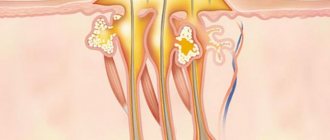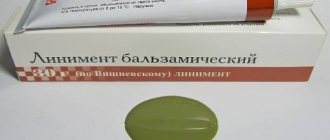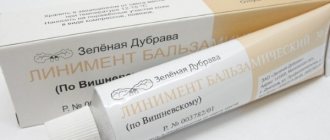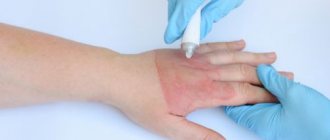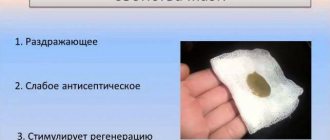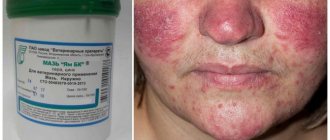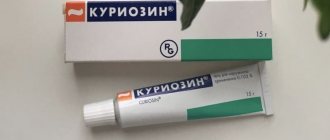"Levomekol" is an antibacterial combination drug for external use with a wide spectrum of action. Levomekol ointment prevents the spread of pathogenic microbes, eliminates swelling, accelerates wound healing, and also increases local skin immunity.
Levomekol for burns
This combination is provided by two active components in the ointment - Chloramphenicol (aka Levomycetin) and Methyluracil. Chloramphenicol is a natural antibiotic that actively blocks intestinal, pseudomonas and staphylococcal bacilli. And methyluracil accelerates the regeneration of the epidermis. The peculiarity of methyluracil is its ability to easily and quickly penetrate into the dermis, without affecting the membrane cell membrane. This process is associated with the removal of excess fluid from the intercellular space, which usually causes swelling and bruising.
What is Levomekol used for?
Levomekol has a multifaceted therapeutic effect:
- quickly reduces the inflammatory process, prevents its spread to healthy tissues;
- prevents the growth and reproduction of bacterial infectious agents;
- quickly eliminates swelling by normalizing microcirculation;
- ensures delivery of nutrients and biologically active substances, as well as molecular oxygen, to the affected tissues;
- stimulates the regeneration of inflammatory cells of all layers of the epidermis;
- increases immunity at the local level.
The ointment quickly removes all inflammatory processes on the skin
It is worth noting that the presence of purulent discharge and necrotic tissue does not prevent Levomekol ointment from performing its function. The drug can be used to disinfect and accelerate tissue regeneration.
Levomekol, ointment for external use, 40 g, 1 pc.
STADA, Russia
Price from 126₽
There are contraindications. Specialist consultation is required.
Composition and release form
This product is a liniment, that is, a “liquid ointment.” An interesting fact is that most liniments, according to the method of application, should be rubbed into the skin (the word liniment itself comes from the Latin verb “linire” - to rub), and Vishnevsky’s liniment is applied in a dense layer under the bandage, like an ointment. Maybe that’s why the name “ointment” was assigned to this remedy. For simplicity of presentation, we will also write “ Vishnevsky ointment ” in the article.
You can read how one form of the drug differs from another in this article.
We propose to understand in more detail the composition of this liniment and what is so special about it.
So, Vishnevsky’s ointment has the following composition:
- Birch tar - 3 parts;
- Xeroform - 3 parts;
- Aerosil - 5 parts;
- Castor oil (castor oil) - 89 parts.
This is a classic recipe and the best. Substitutions are acceptable in pharmaceutical technology, but this composition has absolutely no analogues.
Birch tar is a truly unique substance. It contains phenolic and terpene compounds, including betulin. These compounds cause its pungent, specific odor. It is thanks to him that Vishnevsky’s ointment has a sharp tar aroma, and resinous substances give the tar its dark color.
Molecules of phenolic compounds contain chemical groups of atoms that can attract and bind water. When tar preparations are applied to the skin, these compounds draw water from the deeper layers of the skin. This manifests itself as an osmotic effect. Together with water, toxins, microbes and pus come out of the tissues. Water “pulls” everything with it.
In addition, there is an irritating effect of tar, which manifests itself in improved microcirculation in the lesion.
Betulin is a biologically active substance with a complex structure and has many beneficial properties:
- Anti-inflammatory;
- Antiseptic;
- Antifungal;
- Antiviral;
- Antioxidant;
- Wound healing and regenerating;
- Antimutagenic;
- Dermatotropic;
- Improves trophism in tissues.
And these are only the effects when applied externally. In folk medicine, tar was used to treat problems with the gastrointestinal tract, but we will not dwell on this in this article.
This is what bismuth tribromophenolate looks like
Bismuth xeroform or tribromophenolate is a chemical compound also of phenolic nature, therefore it also has an osmotic and antimicrobial effect. Bismuth ion also promotes anti-inflammatory and tanning (drying) effects. Xeroform has the following properties:
- Astringent;
- Drying;
- Anti-inflammatory;
- Antiseptic;
- Osmotic;
- Acts as a preservative.
Due to the powerful antiseptic effect of these two components, tar and Xeroform, Vishnevsky’s liniment was called “balsamic”. Thereby emphasizing its antimicrobial - embalming properties. Therefore, the name “Vishnevsky’s balsamic ointment” is also often found.
Aerosil - colloidal silicon dioxide, excipient. Acts as a thickener for ointments and liniments.
Castor oil is an emollient and in this case acts as a base. Helps the components penetrate the skin better, since its composition is close to the composition of the skin secretion. It is known for certain that those substances that are of a fatty nature and close in composition to skin lipids penetrate better into the skin.
Indications for use of Levomekol ointment
Since Levomekol ointment has an antibacterial effect, and at the same time stimulates the restoration of tissue structure, the drug is indicated for the following diseases:
- infection of wounds with pathogenic microflora, ulcers and purulent abscesses on the epidermis;
- burns (mostly 2nd and 3rd degree);
- violation of tissue integrity due to injuries;
- necrotic processes;
- weeping and dry eczema;
- calluses;
- trophic ulcers;
- frostbite of the extremities (superficial layers of the skin);
- pimples, acne, carbuncles, boils;
- otitis and sinusitis (including with purulent discharge);
- treatment of sutures after surgery
- bedsores;
- haemorrhoids.
Levomekol ointment can be used for children
"Levomekol" can be used for children from 1 year. But before this, it is imperative to consult a pediatrician.
Use during pregnancy and lactation
It is also possible to use Vishnevsky Ointment during pregnancy, but, of course, according to indications and on the recommendation of a doctor. Considering that this drug is for external use only, and there is no data on the penetration of the drug components into the bloodstream.
Appropriate studies of this drug in pregnant women have not been conducted. Our recommendation is not to use this drug in the first trimester of pregnancy, including due to possible toxicosis. In general, protect yourself from the need to take any medications other than essential ones during pregnancy.
The same applies to the lactation period. If it is necessary to use the drug during lactation, according to the instructions for medical use, breastfeeding should be stopped for a while.
Use in children
It is also permissible to use Vishnevsky Ointment to treat children, but only under the supervision of adults and on the recommendation of a doctor. This is what the instructions say, although the specific age is not indicated there.
We recommend that if there is a need to use this product, you should start using it no earlier than 10-12 years of age, unless your doctor prescribes otherwise in your particular case. As a rule, children do not have such a need due to increased tissue regeneration and good immunity. Necessity here means skin damage accompanied by purulent discharge due to contamination of the wound, and not teenage acne, especially on the face.
Some mothers ask whether Vishnevsky ointment can be used for a child under one year old? Questions like these confuse me.
Firstly , everything that concerns small children, especially under one year old, especially newborns - immediately, immediately, the first thing you need to do is consult a doctor!
Secondly , what has to happen to a child under one year old to require such treatment?!
Vishnevsky ointment is a sharp-smelling substance, such children under one year old, even I would say up to 8-10 years old, are not prescribed, in addition, in the composition of xeroforms, which should not be applied to children, especially small ones, due to the high resorptiveness (permeability, absorption) of the skin children.
Therefore, dear mothers, if you are reading this, monitor your child properly and, of course, first of all, think with your own head.
Contraindications
Like many drugs, Levomekol has contraindications:
- individual intolerance to the components of the medication;
- hypersensitivity of the body;
- fungal infections of the epidermis;
- tendency to allergic reactions;
- psoriasis.
The official instructions for use indicate that in pediatrics the ointment is prescribed starting from 3 years of age. However, many pediatricians, based on the harmlessness of Levomekol, allow its use from infancy.
What are the reasons
Drug allergy is sensitivity to the components of medications. A reaction can occur when even a minimal dose of the drug enters the body. A person's tendency to allergies can be influenced by hormonal changes, for example, during puberty, hereditary disposition, as well as blood composition.
Even climate, season and metabolic characteristics play a certain role. Many experts believe that with a fast metabolism, the tendency to allergies is lower: dangerous substances do not have time to linger in the blood.
Information! In babies, factors that provoke allergies may be endocrine disorders, artificial feeding or inappropriate nutrition of the mother during pregnancy (for example, abuse of preservatives).
Side effects
Levomekol is considered a universal drug and is usually well tolerated by patients. But in case of overdose (if the drug is used for more than a week), allergic skin reactions may occur.
- hyperemia;
- burning;
- itching;
- urticaria;
- dermatitis at the site of application;
- local swelling;
- When using vaginal tampons, candidiasis may occur.
No incompatibility with other medicinal products has been reported. Make sure that the ointment does not get into your eyes, mucous membranes or inside. In case of contact with eyes and mucous membranes, rinse them immediately with running water. If swallowed, the stomach must be rinsed.
How to treat
First of all, it is necessary to stop the patient’s contact with Vishnevsky ointment. Antihistamines are also prescribed to relieve irritation and soothe itching. Enterosorbents will help quickly remove toxins from the body: Smecta, activated carbon.
To quickly eliminate allergic symptoms, hormonal ointments, for example Advantan, are sometimes prescribed. You can use them no longer than a week, otherwise side effects and addiction may occur.
Sometimes the doctor recommends making some changes in hygiene procedures. He may advise you to wash more often or, conversely, less often, replace tap water with boiled water, and add acidifiers to the water. Women will have to temporarily give up chemical cosmetics that can worsen the manifestations of allergies.
To make the symptoms go away faster, we must not forget about traditional medicine recipes. Shilajit, lotions using a decoction of St. John's wort or string will help relieve irritation and calm the body.
Diet plays an important role in the treatment of allergies. Prohibited products include citrus fruits and peaches, sausages and smoked meats, mayonnaise, ketchup and other sauces. Coffee and chocolate, margarine and refractory fats, fried and spicy foods are strictly not recommended.
Levomekol in the treatment of burns
For burns, Levomekol is needed to prevent infection of the wound surface with pathogenic infections, as well as to accelerate tissue healing. Levomekol also copes with inflammation, which can lead to suppuration of the wound. The ointment cleanses the affected area well from both purulent discharge and necrotic cells.
The treatment system for a small area burn of 1-2 degrees is as follows:
- before applying the ointment, the wound is washed under running water;
- the ointment is applied to a sterile gauze pad, which is applied to the wound surface;
- the bandage is applied for a day;
- dressings are done every day - up to 5 times a day.
The burn is treated until the tissue is completely healed. The total duration of the course for minor household burns is 5 – 14 days.
Levomekol in the treatment of acne
"Levomekol" has an antibacterial and wound-healing effect, therefore it is widely used in dermatology, in particular, in the treatment of acne. The course of treatment depends on the severity of the disease and the number of skin rashes.
Small pimples are treated by applying a thin layer of ointment to the affected area. This is done in the evening for several hours, and before bedtime Levomekol is washed off. Within two weeks, pimples disappear, facial skin becomes even, and small scars heal.
Treating acne with ointment
Levomekol is applied to isolated inflamed pimples in a thin layer, covered with a small piece of cotton wool and left for 2-3 hours. Therapy lasts 2-3 days.
As for opened pimples, the medicine is placed directly into the resulting holes.
To treat acne, Levomekol is applied to the affected area overnight. In the morning, the ointment must be washed off. Typically, the course of treatment takes 2 weeks, during which the inflammation subsides and the acne breaks out or resolves.
To eliminate subcutaneous acne, you need to do the following:
- after washing with soap, the skin is cleansed with any tonic or lotion;
- Apply the ointment in a thin layer on a sterile napkin and apply it to the area of skin with acne;
- the bandage is fixed with adhesive tape.
The duration of the treatment procedure is 3-5 hours. If deep, painful ulcers appear on the skin, keep the bandage on the body all night.
The duration of therapy is about 7-10 days, depending on the degree of damage to the dermis.
Levomekol in the treatment of hemorrhoids
Levomekol ointment can be used as an addition to complex therapy for hemorrhoids during periods of exacerbation. It is recommended to use the ointment in cases where blood is released from the hemorrhoids. Since the drug has an antibacterial effect (wounds can be infected with feces), helps relieve inflammation and neutralize pathogenic bacteria, Levomekol is prescribed for the regeneration of anal tissue.
- it is necessary to wash the perineum and anus with soap and water and dry with a soft towel;
- apply a thin layer of ointment to the anus before going to bed;
- the area of influence from above is covered with a bandage and fixed with an adhesive plaster;
- When treating internal nodes, a tampon is soaked in ointment, which is then inserted into the anus.
Levomekol for hemorrhoids
The duration of therapy is 10 days. Since Levomekol is not a specialized antihemorrhoidal drug, after the inflammation has resolved, the decision to continue therapy and prescribe medications is made only by the attending physician.
Instructions for use
Vishnevsky ointment according to instructions for medical use from several manufacturers:
- Apply externally in a thin layer;
- A bandage soaked in liniment is applied to the wound;
- Used as a compress.
This is all completely wrong.
And that's why:
- When applied in a thin layer, a sufficient therapeutic effect of this drug does not develop.
- The liniment should not saturate the dressing, but should come into contact with the skin. And when soaked, most of the product will remain in the dressing material.
- A compress is the application of a bandage soaked in a liquid solution, and this liniment certainly cannot be called liquid.
So, how to use this remedy correctly?
Levomekol in the treatment of wounds
Levomekol helps heal damaged tissue and prevents infection of the wound surface. Moreover, it is not so important whether the wound has festered or not. If the wound is not purulent, then first the affected area is treated with an antiseptic. The ointment is applied in a thin layer overnight, then it must be covered with a sterile gauze cloth and secured with a bandage. Most often, wound treatment is required once a day.
If the wound festers, then using cotton-gauze swabs moistened with an antiseptic, the pus and secreted secretions are removed. Then Levomekol ointment is applied to the wound - it should be completely filled, but not too tightly. The affected area is covered with a gauze cloth, also soaked in ointment. As for the frequency of changing the bandage, it all depends on the amount of pus released. Usually a double dressing is sufficient.
And if the wound is deep and accompanied by an infectious lesion, then Levomekol is preheated to 35 degrees Celsius, then a sterile napkin is soaked in ointment (several can be used if the affected area is large) and injected into the lesion. If the affected area is large, use several napkins with Levomekol. It is important that the wound is filled completely, but not too tightly.
Note that to administer the medication into puncture and deep wounds, it is better to use a rubber drainage tube, and inject the heated ointment itself using a syringe.
The duration of therapy usually lasts from 5 to 10 days.
Overdose
The proportion of plant-based, environmentally friendly components in the ointment is large. The balm is intended only for external local use, applied in a thin layer or soaked in gauze bandages and tampons with the medicinal mixture. Therapy is prescribed in dosed courses. Signs of overdose are observed only with prolonged use of the drug. Rash, itching, redness, peeling and other allergic skin reactions appear in a mild form. When you stop using the drug, the symptoms disappear.
Use of Levomekol ointment in gynecology
Levomekol is successfully used in gynecology and urology.
In gynecology, therapy is carried out using tampons with ointment applied to them. A similar method is indicated for the treatment of the following conditions:
- inflammatory erosion of the cervix;
- inflammation of the uterine appendages (ovaries, fallopian tubes);
- divergence of vaginal sutures after ruptures during childbirth or operations.
The treatment system consists of the following sequence of actions:
- before use, a woman must thoroughly wash and dry the skin of the treatment area and perineum;
- if therapy is used after the divergence of vaginal sutures or after operations, then the sutures must be treated with a weak solution of potassium permanganate or furatsilin;
- you need to make a small cotton swab, put an ointment on top of it measuring 15 mm x 15 mm, and 5 mm high;
- insert into the vagina at night and remove in the morning;
- if therapy is used after the divergence of vaginal sutures or after operations, then the ointment is applied to a gauze bandage and applied to the sutures. Then put on clean underwear (if necessary, you can additionally use a pad). The dressing remains on for 2 to 6 hours.
Using the method described above, the active substance of the ointment is delivered to the affected area and absorbed into the surrounding vaginal tissue.
In urology, Levomekol is used in the treatment of balanitis and balanoposthitis in men, as it has anti-inflammatory and antimicrobial effects. The treatment system consists of the following sequence of actions:
- before applying the ointment, the head of the penis is washed with a weak solution of potassium permanganate or furatsilin, removing pus and dead tissue;
- Levomekol is applied to the affected area in a dense layer.
The remedy is applied 1-2 times a day until complete recovery. After the inflammation is relieved, Levomekol is applied for another week, 1 time per day - in the evening, before bedtime.
Levomekol or Vishnevsky ointment. What's better?
Let's start with the fact that Vishnevsky ointment and Levomekol, although they are used in similar cases, still have a multidirectional spectrum of action. Thus, Vishnevsky ointment is effective when the wound is in the process of regeneration. Therefore, it cannot be used when the wound is suppurated or severely inflamed. Yes, the drug contains an antiseptic, but its concentration is not enough to provide a bactericidal effect. Moreover, tar and castor oil stimulate blood circulation in the affected area, which worsens the situation.
This is why Vishnevsky’s ointment is not as effective, since Levomekol has higher antibacterial activity due to the presence of an antibiotic in it and accelerates the process of outflow of pus from the wound. Also important are the following distinctive features that determine the superiority of Levomekol ointment:
- no unpleasant odor;
- higher repair characteristics;
- does not provoke irritation in the treatment area;
- when treating boils, Levomekol quickly initiates an abscess and opening of the abscess, followed by wound healing.
But if Vishnevsky ointment helps the patient, then there is little point in changing it.
Vishnevsky ointment: indications
Vishnevsky ointment, the composition of which is very simple, is indicated for the treatment of various injuries to the skin and soft tissues. Liniment is most often prescribed for treatment:
- Acne and abscesses of various etiologies.
- Boils.
- Ulcers caused by diabetes or caused by varicose veins.
- Infected purulent wounds.
- Burns and extensive abrasions.
- Bedsores.
- Gynecological pathologies.
- Hemorrhoids.
Analogs
Analogs of Levomekol ointment have a bactericidal and healing effect. But the difference lies in the active ingredient of the drug. So, among the analogues one can name Fugentin, Levosin (additionally has an analgesic effect), Protegentin, Fastin-1, Salicylic-zinc paste.
Synonyms, that is, drugs with the same substance (but in higher concentration) as Levomekol ointment, can be considered Netran and Levomethyl. Substitute medications can only be prescribed by the attending physician.
Compound
The liniment consists of three components; the name Vishnevsky balm is associated with their colossal healing power:
- xeroform powder has a strong antiseptic effect, it contains bismuth, bromine, and phenol salts, it promotes active tissue regeneration;
- birch tar improves blood circulation, promotes enhanced nutrition of soft tissues, a natural, environmentally friendly substance, it contains about 10,000 useful components;
- Castor oil improves the penetration of active substances deep into tissues and is of plant origin.

